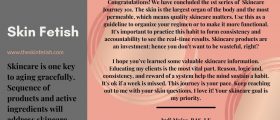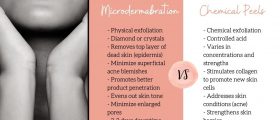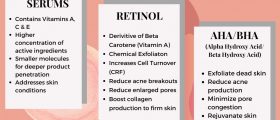Chemical Peels: Know the Types and Benefits
by Judi Moise | Posted: August 22, 2017 | Chemical Peels
Chemical peels: A great way to revive your skin after the Summer’s heat. Depending on your desired results, chemical peels can minimize age spot caused by the sun and diminish fine lines and wrinkles. Variations of chemical peels makes customizing manageable for most skin tones, types and conditions. The word PEEL can be deceiving because YOU MAY NOT PEEL THE FIRST TIME! Let’s look at different chemical peels according to its features and benefits.
Chemical peel: a solution that’s applied to the skin, causing accelerated exfoliation which eventually peels off the epidermis (DEAD skin). New skin will emerge with less imperfection, which can be noticed after one session. Typical areas for chemical peels include the face, neck and hands. Chemical peels come in light, medium or deep formulation to address different skin concerns.
The ph of the skin is about 5.5. Chemical peels contain a lower ph to reach the dermis (LIVE skin). What’s so special about the dermis? This is where the magic happens.
- Dermis (LIVE skin) is about 25 times thicker than the epidermis (DEAD skin)
- Produce collagen and hyaluronic acid: gives skin’s contour and smoothness
- Sebaceous glands are formed; producing oil
- Where base of hair follicle is located
First introduced by the beautiful Cleopatra, achieving luminous skin was a necessity, for even skin tone meant royalty. She bathed in donkey milk to soften and brighten her skin. Oil, salt and alabaster was also used to improve skin tone. Chemical peels have advanced over the years by adding to these discoveries.
Enzyme: the gentlest form of exfoliation. It accelerates skin’s cell turnover by using natural ingredients such pumpkin, papaya, and pineapples to “eat away”dead skin. Contains potent antioxidants to normalize the skin and brighten skin tone. Enzymes does not contain acid so it’s practical for most skin types, if allergies aren’t a factor.
Lactic Acid is the lightest of chemical peels. It contains a natural alpha-hydroxy acid (AHA)that exfoliates the skin to improve hyperpigmentation, or evens out the skin tone.
Glycolic acid is an AHA that’s sugar derived. It dissolves the internal cellular cement to help slough off dead skin. Glycolic improves hydration by binding water throughout skin layers. Great to minimize wrinkles and reduce rosacea symptoms.
Salicylic Acid or Beta peel is an oil loving chemical peel containing beta hydroxyl. It reduces sebaceous follicle blockage to minimize acne. Oil production is decreased as well.
Jessner & TCA are medium peels that penetrate deeper in the skin. Jessner contains a fusion of 14% salicylic acid, 14% lactic acid and 14% Resorcinol. ph of the peels may vary by brand. TCA may come in various strengths and fusions. These peels smooth deep wrinkles and severe hyperpigmentation. Be warned that lighter skin tones will experience hyperpigmentation after a couple of days. Don’t be alarmed. Â The dead skin darkens while new skin is forming. Beautiful, nourished skin will be revealed after 4-7 days. The process can be visibly unappealing so plan on staying in if you don’t want any random stares.
Phenol is a deep peel considerably stronger the all the peels. Main ingredient is carbolic acid, derived from petroleum. Anesthesia is needed to receive this peel. The down time is extensive, but the results will last for years. Not as popular since laser resurfacing was introduced.
I hope the explanation is helpful to your skincare journey. Now that you’re informed, I recommend an experienced aesthetician, dermatologist or PA to apply these peels for positive results.
Like and Share! Stay tuned to learn more about chemical peels.
This blog DOES NOT reflect medical advice, diagnoses, or treatments.












Leave a Reply
Be the First to Comment!